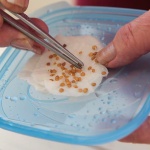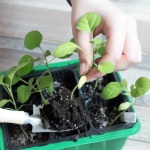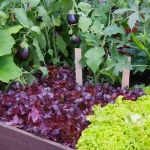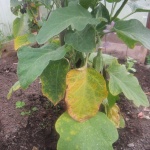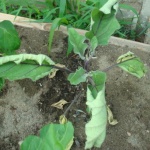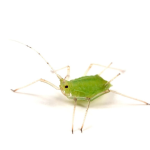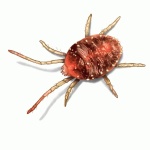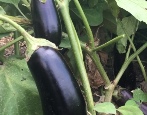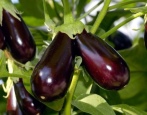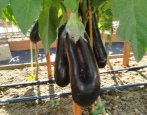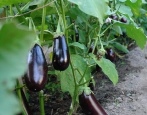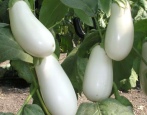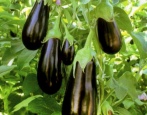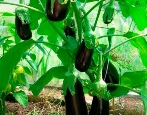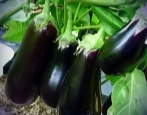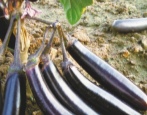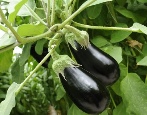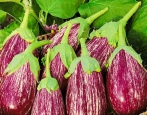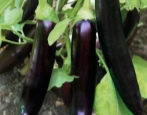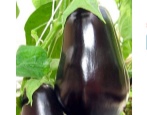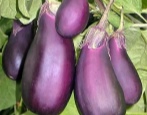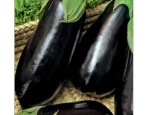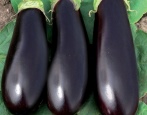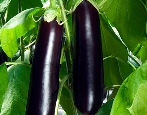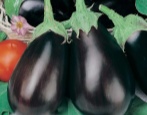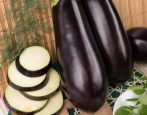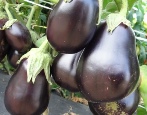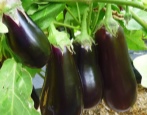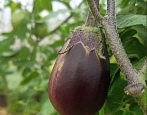
- Authors: Blokin-Mechtalin V.I.
- Year of approval: 2020
- Growth type: vigorous
- Bush height, cm: 90-100
- Fruit shape: clavate, slightly curved
- Fruit weight, g: 190-220
- Fruit color: dark purple
- Ripening terms: mid-season
- Pulp (consistency): dense
- Color of the pulp: whitish
Eggplant with the funny name Andryusha is a young hybrid created in 2020 by the famous breeder Blokin-Mechtalin. The plant is recommended for those who are just starting their journey as a vegetable grower.
Description of the variety
The mid-season hybrid of Andryusha belongs to varieties with a universal purpose. He is very fond of novice agrarians, as well as summer residents living in areas of risky farming. Here are the main positive characteristics of Andryusha:
- widespread cultivation;
- excellent yield performance in closed and open soil types;
- weighty, even and beautiful fruits that attract the attention of buyers;
- delicate taste with light tart notes;
- the ability of the bushes to tolerate cold and heat;
- excellent resistance to ailments.
The gardeners have not yet been able to find any grandiose shortcomings, because this is a very young culture. However, summer residents noticed that it was necessary to properly organize the irrigation regime. Only in this case will it be possible to get juicy and tasty fruits.
Characteristics of the appearance of plants and fruits
The bushes of the hybrid variety belong to the vigorous group. Their height often reaches a meter. The bushes are semi-sprawling, the stems are pubescent, with a light anthocyanin coloration. The foliage is green, smooth, with a slight waviness along the edges. The plates do not differ in large dimensions, they have standard dimensions. Small spines are present on the calyx.
Fruits grow even, clavate, with slight curvature. The classic length of eggplants is 20-22 centimeters, but in rare cases there are fruits of 30 cm each.The diameter is usually 10 cm, sometimes 6-7 cm.The standard weight is 190-220 grams, the maximum is 250 g. Eggplants are colored dark purple , almost black tone. Very shiny. The pulp is dense and light, with a minimum of seeds.
Purpose and taste
Andryusha's fruits are characterized by a delicate taste, there are no bitter notes at all. Gardeners use eggplants in different ways. For example, you can fry or bake them, or grill them as an addition to meat. Eggplant caviar from Andryusha is also very good. Also, the fruits can be used in the manufacture of stews, put them in mixed vegetable mixes, used to make winter salads and various preparations.
Ripening terms
The plant is mid-season, and it is customary to expect the harvest 130-135 days. The agrarians are collecting fruits from the second month of summer until October, which allows us to talk about extended periods of fruiting. Even with the starting autumn cold, the crop does not lose its qualities.
Yield
Eggplant is a fruitful crop, because basically you can get 7.5 kg (square meter) from it. But according to some reports, gardeners collect both 8 and 10 kilograms of juicy eggplants.
Growing regions
Andryusha's culture can be grown in protected and open ground. This greatly expands the possibilities of summer residents, therefore cultivation is actively carried out in all regions of the country, including those that are risky for agriculture. These include, for example, Siberia.
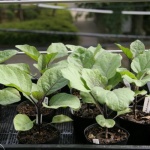
To get a tasty and bountiful eggplant crop, you must first grow strong and healthy seedlings. This culture is considered very capricious, therefore, you need to take care of seedlings when growing at home as correctly and carefully as possible.
Landing scheme
It is customary for Andryusha to plant using the tape technique. It assumes a step between plants of 40 cm, and as for the rows, here the distance should be equal to 55 cm. A square meter of soil is a place for 4 bushes, no more. Sometimes a staggered landing order is also preferred. But this applies more to beginners who are not yet familiar with all the features of proper care.
Growing and care
It is recommended to grow a hybrid of Andryusha using the seedling method, then the harvest can be obtained a little earlier. The optimal time for sowing is late winter - early spring. Seeds should be purchased from trusted suppliers, for example, from the partner agricultural firm.
First of all, the grains are soaked for a day. To do this, you can use plain warm water to maintain its temperature. Then it is customary to use growth stimulants. The containers are prepared small, since Andryusha does not perceive the abundance of excess land poorly. Drainage, a vermiculite layer, and then a substrate are placed on the bottom. Good soil should have the following composition:
- peat;
- compost;
- ash;
- biohumus;
- phosphorus and potassium (top dressing).
It will take about 2 months to take care of the plants, and then in May they can be transplanted into open ground. Important: a few days before Andryusha's transplant, the number of waterings must be reduced.
The first watering is carried out immediately after planting the young in the ground. Andryusha loves moist soil, like all eggplants, so it is impossible to allow the top layer to dry out constantly. This can be only for a short time, if you want to get a really juicy harvest.
In the absence of precipitation, the culture is watered twice a week, and if the drought is severe, then as many as 3 times. But a rainy summer dictates different conditions: watering every 10 days, or even less often, depending on the frequency and amount of rain. Important: when the eggplants begin to ripen, you will have to water a little more often.
Most of the fertilizer is placed in the soil before the eggplant is planted. We are talking here about the autumn digging and fertilization of the site with useful organic matter, such as compost or humus. Wood ash will also be very good for the soil. Subject to the availability of such fertilizers in the soil, it will be necessary to feed Andryusha to a minimum. It will be enough 2 times during the growing season. The first time you can use organic matter, and the second time - a complex mixture of minerals and vice versa. Some gardeners generally limit themselves to one feeding.
So that the bushes do not lack oxygen, the soil must be loosened after irrigation or rain. During this, it will be useful to eradicate weeds. The originators recommend forming Andryusha in three stems. This is the best way to get rich harvest.
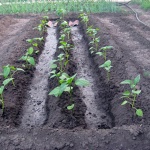
Planting eggplant is one of the most important stages in growing. When choosing a place for eggplants on your site, it is important to remember that this culture should be in warm soil, constantly illuminated by the sun. The plant is also very fond of spacious, open spaces, since its roots can grow over sufficient areas.


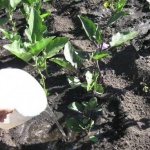
Soil requirements
Andryusha likes moist and well-drained soil. The culture grows well on soils, the acidity level of which is equal to 6.3-6.8 pH. You can grow this kind of eggplant on black earth or loamy substrates.
Required climatic conditions
The planting of eggplants of the described variety is carried out exclusively in sunny areas, protected from gusts of wind by buildings or tall trees, corn, sunflowers. Andryusha easily tolerates temperature fluctuations, cold. It is considered a drought-resistant crop, but it will not tolerate a constant lack of moisture, responding with a dry and not particularly juicy harvest.
Disease and pest resistance
The plant is renowned for its resistance to the tobacco mosaic virus. But late blight or rot can become frequent guests if the gardener intends to water the bushes almost daily. Watering should be, but according to the regime, otherwise the fungus cannot be avoided. If you are not yet confident in your abilities and are just learning to comply with the necessary conditions, then from time to time treat the bushes with Fitosporin-M.
It is worth mentioning that greenhouse crops can be affected by the whitefly, but in the open field, the Colorado potato beetle and aphid are often found. It is better not to wait for the spread of insects, but to immediately begin to fight them, and it would be good to use folk methods. For example, infusion of garlic, tobacco dust, wood ash. In the absence of a result, it is permissible to use insecticides.
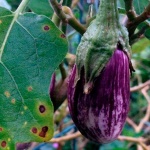
Eggplant is one of the most demanding crops. For its successful cultivation, it is necessary to create optimal conditions, as well as to carry out prevention and fight against diseases and pests. Eggplant often infects both fungal and viral diseases. If treatment is not started on time, you can completely lose the crop.
